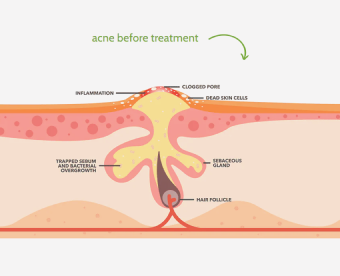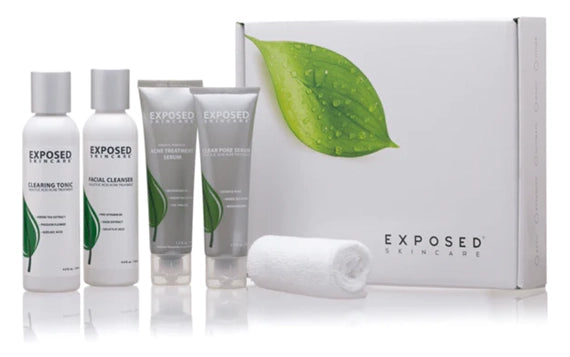Acne is a common skin condition that can be frustrating and challenging to treat. You may have come across glycolic acid as a potential solution in the quest for clear skin. So, does glycolic acid help with acne?
This guide will dive into the world of glycolic acid, its benefits, and how to incorporate it into your skincare routine for a clearer, smoother complexion.
Also read: How to choose the best acne treatment
Biggest Take-Aways:
-
Glycolic acid effectively treats acne by exfoliating dead skin cells, unclogging pores, and improving skin texture.
-
When using glycolic acid, start with lower concentrations, moisturize, and wear sunscreen to protect your skin.
-
Combining glycolic acid with other acne treatments, such as benzoyl peroxide or salicylic acid, can yield better results.
-
Exposed Skin Care provides a comprehensive acne solution, combining powerful ingredients like glycolic acid with natural extracts for optimal skin health.

What is Glycolic Acid?
Glycolic acid is an alpha hydroxy acid (AHA) derived from sugar cane. It is one of the most commonly used and studied AHAs in skincare products. Known for its exfoliating properties, glycolic acid effectively removes dead skin cells, unclogs pores, and helps to improve overall skin texture.
How Does Glycolic Acid Work?
Glycolic acid works by dissolving the bonds between dead skin cells on the outer layer of the skin, allowing for their easy removal. This process, known as chemical exfoliation, promotes skin cell turnover, leading to a smoother and more even complexion.
The Benefits of Glycolic Acid for Acne-Prone Skin
Using glycolic acid on acne-prone skin offers numerous benefits, including:
-
Exfoliation: Glycolic acid's ability to remove dead skin cells helps to prevent clogged pores, which can contribute to acne breakouts.
-
Increased cell turnover: Faster cell turnover can help reduce the appearance of acne scars and dark spots and prevent new acne breakouts.
-
Improved skin texture: Regular use of glycolic acid can lead to a smoother, more even skin texture.
-
Collagen production: Glycolic acid boosts collagen production, which can help to improve skin elasticity and reduce the appearance of fine lines and wrinkles.

Glycolic Acid vs. Other Acne Treatments
When treating acne, several active ingredients are commonly used, including salicylic acid, benzoyl peroxide, and lactic acid. Here is a comparison of how glycolic acid stacks up against these other acne treatments:
-
Salicylic acid: This beta hydroxy acid (BHA) is oil-soluble, making it more effective at penetrating deep into the pores to dissolve excess sebum and dead skin cells. It is especially beneficial for oily skin and is often used to treat acne breakouts. However, glycolic acid may be more suitable for sensitive skin types, as it is less irritating than salicylic acid.
-
Benzoyl peroxide: This antimicrobial agent kills acne-causing bacteria on the skin's surface. While it can be effective in reducing active acne, it may not be as effective in addressing acne scarring or hyperpigmentation. Glycolic acid, on the other hand, can help to improve skin tone and texture, making it a more versatile acne treatment.
-
Lactic acid: This AHA is derived from milk and is gentler than glycolic acid, making it more suitable for highly sensitive skin. However, glycolic acid is generally more effective at exfoliating and improving skin texture.
How to Use Glycolic Acid for Acne
Glycolic Acid Products
Various glycolic acid products are available, including cleansers, toners, serums, and peels. When incorporating glycolic acid into your skincare routine, choosing the right product for your skin type and concerns is essential.
-
Cleansers: Glycolic acid cleansers are an excellent option for those new to chemical exfoliation, as they are typically formulated with a lower concentration of glycolic acid. This makes them suitable for daily use, gently exfoliating the skin without irritating it.

-
Toners: Glycolic acid toners are a convenient way to incorporate the acid into your skincare routine. They can be applied after cleansing to remove any remaining dead skin cells and provide additional exfoliation.
-
Serums: Glycolic acid serums typically contain a higher acid concentration, making them more potent and effective at treating acne and improving skin texture. These serums should be used sparingly and gradually introduced into your skincare routine to avoid over-exfoliation and irritation.
-
Peels: Glycolic acid peels are professional treatments that involve the application of a high concentration of glycolic acid to the skin for a short period. These peels can significantly improve skin texture and the appearance of acne scars but should be performed by a qualified professional.
Tips for Using Glycolic Acid Safely
To ensure that you are using glycolic acid safely and effectively, follow these tips:
-
Patch test: Before using a new glycolic acid product, perform a patch test on a small area of skin to ensure that you do not experience any adverse reactions.
-
Gradually introduce: Start using lower concentrations of glycolic acid products and gradually increase their strength and frequency as your skin becomes more accustomed to the treatment.
-
Wear sunscreen: AHAs, including glycolic acid, can increase your skin's sensitivity to the sun, so be sure to wear sunscreen daily to protect your skin from harmful UV rays.
- Moisturize: Glycolic acid can be drying, so it's essential to use a moisturizer after applying glycolic acid to help your skin retain moisture and maintain its barrier function.

How Often Should You Use Glycolic Acid for Acne?
The frequency of using glycolic acid for acne depends on the product, concentration, and skin type. Generally, glycolic acid cleansers and toners can be used daily, while serums and peels should be used less frequently.
-
For glycolic acid serums, start by using them once or twice a week and gradually increase the frequency based on your skin's tolerance and reaction.
-
Glycolic acid peels should only be performed as recommended by a professional, typically every 4-6 weeks.
Exposed Skin Care: A Comprehensive Solution for Acne Management
Exposed Skin Care is a well-known acne treatment system combining science and nature to effectively manage acne and promote healthy skin.
The benefits of using Exposed Skin Care for acne management include:
-
Combination of powerful ingredients: Exposed Skin Care incorporates a unique blend of active ingredients, such as benzoyl peroxide, salicylic acid, glycolic acid, and natural extracts like tea tree oil, green tea extract, and licorice root extract. This combination targets acne from multiple angles, addressing various acne-causing factors.
-
Reduced inflammation: The natural ingredients in Exposed Skin Care help to soothe and reduce skin inflammation, which can contribute to acne breakouts and discomfort.
-
Balanced skin: Exposed Skin Care balances sebum production and maintains the skin's natural moisture barrier, preventing excessive dryness or oiliness.
-
Prevention of new breakouts: By targeting acne-causing bacteria and unclogging pores, Exposed Skin Care helps to prevent new acne breakouts from forming.
-
Fading of acne scars: The inclusion of glycolic acid in Exposed Skin Care products helps to fade acne scars and improve skin texture over time.
-
Suitable for all skin types: Exposed Skin Care offers various products tailored to different skin types and concerns, making it suitable for everyone, from those with oily or sensitive skin to those with dry or combination skin.
Incorporating Exposed Skin Care into your skincare routine can provide a comprehensive solution for managing acne, promoting clearer, healthier skin, and preventing future breakouts.
Conclusion
Glycolic acid is a potent and versatile treatment for individuals with acne-prone skin, effectively exfoliating dead skin cells, unclogging pores, and enhancing skin texture. When used responsibly, it can help diminish acne scars, dark spots, and promote a smoother, more even complexion.
Incorporating glycolic acid products into your skincare routine and other acne treatments, such as benzoyl peroxide or salicylic acid, can yield optimal results. Furthermore, comprehensive acne solutions like Exposed Skin Care can provide a multi-faceted approach to managing acne by combining powerful ingredients with natural extracts for healthier, clearer skin. By following the guidelines and tips outlined in this article, you can harness the benefits of glycolic acid and achieve the radiant skin you've always desired.
Frequently Asked Questions
How Long Does It Take for Glycolic Acid to Clear Acne?
The length of time it takes for glycolic acid to clear acne varies depending on the individual, the severity of the acne, and the specific glycolic acid product being used. Some people may see improvements in their skin within a few weeks, while others may need several months of consistent use to achieve noticeable results.
Can I Apply Glycolic Acid on Active Acne?
Yes, glycolic acid can be applied to active acne. However, it is essential to use a gentle formula and avoid over-exfoliating or irritating the skin, as this can worsen acne and lead to further breakouts.
Which is Better for Acne: Glycolic or Salicylic Acid?
Both glycolic and salicylic acids can effectively treat acne, but their suitability depends on your skin type and concerns. Glycolic acid is generally more effective at improving skin texture and addressing acne scarring.
On the other hand, salicylic acid is more effective at penetrating deep into the pores to dissolve excess sebum and dead skin cells, making it particularly beneficial for oily skin. If you have sensitive skin, glycolic acid may be a better option due to its lower potential for irritation.
Can I Use Glycolic Acid with Other Acne Treatments?
Yes, glycolic acid can be combined with other acne treatments, such as benzoyl peroxide or salicylic acid. However, it's important to introduce each product gradually and monitor your skin's reaction to avoid over-exfoliation or irritation.
Can I Use Glycolic Acid Daily for Acne Treatment?
Using glycolic acid daily is generally not recommended, especially when starting the treatment. Overuse can lead to skin irritation, dryness, and redness. Instead, begin by using glycolic acid products 1-2 times a week, gradually increasing the frequency as your skin adapts.
Keep in mind that the ideal frequency depends on your skin type, product concentration, and other skincare products in your routine. Always pay close attention to your skin's reactions and adjust the usage accordingly to maintain a healthy balance.
















